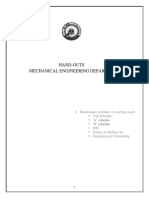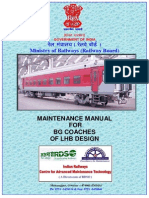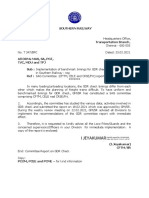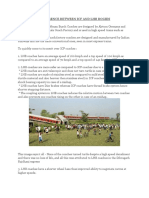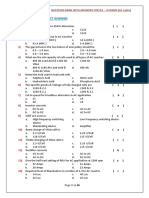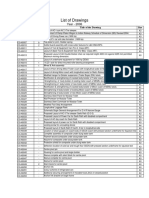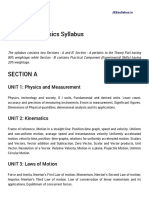ODC
ODC
Uploaded by
majji satishCopyright:
Available Formats
ODC
ODC
Uploaded by
majji satishCopyright
Available Formats
Share this document
Did you find this document useful?
Is this content inappropriate?
Copyright:
Available Formats
ODC
ODC
Uploaded by
majji satishCopyright:
Available Formats
MOVEMENT OF OVER DIMENSIONAL CONSIGNMENT, OTHER BULKY CONSIGNMENTS AND SPECIAL STOCK
CHAPTER 12
MOVEMENT OF OVER DIMENSIONAL CONSIGNMENT, OTHER BULKY CONSIGNMENTS AND SPECIAL STOCK
1201
Definition : Consignments, which when loaded upon a wagon, would infringe the maximum standard moving dimensions, at any point, on the entire route, from the booking station to the destination, including via break of gauge is called an Over Dimensional Consignment (ODC). Therefore, any consignment exceeding the dimension quoted below shall not be registered for booking unless prior sanction for its acceptance has been obtained from the COMChurchgate.
1202
Maximum Moving Dimensions from rail level(at any point) : Description BG (MM) Height at Centre Height at sides Maximum Width 4115 3505 3050 for Bogie Wagon 3200 for 4 wheeled Wagon Gauge MG (MM) 3430 3200 2590 NG (762 MM) 3200 2895 2286
Note: (i) Above mentioned dimensions include lashing and packing. (ii) When a dummy truck is used, the maximum weight that may be loaded, in any wagon or truck is distinctly marked on each vehicle and must not be exceeded. Maximum Dimensions of articles which will not ordinarily infringe the maximum moving dimensions on the respective gauges are also given below for general guidance : Description BG (MM) Length (in 4 wheeled wagon) (in Bogie wagon) Height at Centre Height at sides Maximum width: (In Bogie wagon) (In 4 wheeled wagon) 7010 13716 2794 2185 3050 3200 Gauge MG (MM) 4877 13106 2490 2235 2438 2591 NG (762 MM) -8839 2400 2146 2286 --
Note: (i)These dimensions include lashing and packing. (ii) In case of inter-gauge movement, the lowest dimensions of any gauge will apply. 1203 Maximum Permissible Dimensions of Rolling Stock : Maximum overall dimensions taken from rail level, in order to calculate readily the maximum height of a consignment that can be transported and height of wagon floor from the rail level are shown below for general guidance:
67
MOVEMENT OF OVER DIMENSIONAL CONSIGNMENT, OTHER BULKY CONSIGNMENTS AND SPECIAL STOCK
1. Broad Gauge : Floor Height of converted bogie Floor Height of four wheeler Floor Height of MBFU (Well wagon) Floor Height of BFU/BWL Height of side girder Well length 2. Meter Gauge : Floor MBFU (Well Wagon) Well length of MBFU (Well Wagon) Floor of four Wheeler Floor of Converted Bogie Floor of USA bogie wagon Floor of W.Rly. BWL Well length of W.Rly. BWL Width of W.Rly. BWL Floor Height of W.Rly BWL 3. Narrow Gauge : Bogie Four Wheelers 1204 Classification of ODC consignment : ODCs are divided into 3 classes according to the minimum clearance available between the consignment and minimum fixed structure profile. Class A: Those ODC loads, which have a gross clearance of 22.86 cm (9 inches) and above and net clearance of not less than 15.24 cm (6 inches) from the fixed structure all round but which nevertheless infringes the standard moving dimensions. Those ODC loads, which have a gross clearance of 15.24 cm (6 inches) and above, but less than 22.86 cm (9 inches), and a net clearance of not less than 7.62 cm (3 inches) but less than 15.24 cm (6 inches) from the fixed structure. Those ODC loads, which have a gross clearance of less than 15.24 cm (6 inches) but not less than 10.16 cm (4 inches) and net clearance of less than 7.62 cm (3 inches) but not less than 2.54 cm(1 inch) from the fixed structure. Gross clearance means the extent of clearance when the consignment is stationary. Net clearance means the extent of clearance after allowing for horizontal lurching and vertical bouncing. 813 mm 762 mm 603 mm 3810 mm 864 mm 1086 mm 1105 mm 487 mm 9754 mm 2261 mm 489 mm 1308 mm 1232 mm 686 mm 457 mm 864 mm 9449 mm
Class B:
Class C:
Note: (i)
(ii)
68
MOVEMENT OF OVER DIMENSIONAL CONSIGNMENT, OTHER BULKY CONSIGNMENTS AND SPECIAL STOCK
Sanctioning Authority Class A Within Division : DRM Inter Div/W.R. COM Inter Rly.: COM-WR and COM of concerned Rly. Local : DRM Inter Div/fgn.Rly.: COM
Maximum Permissible Sanctioned Speed
Movement Required to During be escorted Day or Night by
BG-40 KMPH MG-25 KMPH NG-15 KMPH
Day & Night
BG-40 KMPH MG-25 KMPH NG-15 KMPH BG-40 KMPH MG-25 KMPH NG-15 KMPH
Day & Night
SE (C&W)
CRS
Day
SE (C&W) SE(P.Way) TI
Net Clearance : The net clearance shall be worked out as under : The net clearance between the consignment as loaded in the train and any fixed structure should be calculated after making an allowance of 75 mm (3 inches) for lurch (horizontal) and 7.62 cm (3 inches) bounce (vertical) on the straight together with following additional factors applicable only when the structure in question is situated on a curve. 1. Horizontal Clearance : (a) Allowance for lean due to super-elevation and over hang due to curvature. The lean should be calculated for that point on the profile of the load which is likely to have the smallest clearance from fixed structure the formula being :HC G where H = height in feet to the point being considered. C = Super elevation G = gauge. For the central overhang due to curvature, the formula will be :- B2 8R where B = distance between bogie centre R = Radius of curve. In cases where the overhang at the end of a vehicle may have to be calculated by the formula will be :- L2-B2 8R where L is the length of the vehicle. (b) Additional lurch on curves may be taken 38 mm.
2. Vertical clearance : In case where the top width of the consignment exceeds the gauge of the track the vertical tilt should be added to the height of consignment to work out the vertical clearance from the fixed structure. 69
MOVEMENT OF OVER DIMENSIONAL CONSIGNMENT, OTHER BULKY CONSIGNMENTS AND SPECIAL STOCK
1205
Procedure for sanctioning movement of ODC : When ODC consignment is offered at a station for booking SS/SM will verify if the consignment exceeds the maximum moving dimensions from originating station to destination station including via. and break of gauge, if involved. He should apply to the Sr.DOM, who will obtain the necessary sanction of the competent authority. An application must show the length, width, height, and weight of the load accompanied by a sketch in duplicate of the consignment. In communicating sanction for the movement of ODC, specific route, through which the particular consignment will move, should be indicated, and it will be the responsibility of the SS/SM of the station from which the load originates. In addition to strictly adhering to the specific route, the restrictions (eg. speed restrictions, night running restrictions, platform restrictions etc.) notified for conveyance of the consignment over the route, must be adhered to, and no relaxation in this regard is permitted.
1206
Loading : On receipt of the sanction, the consignment should be loaded carefully, lashed and packed properly, so as to avoid any change of shifting enroute. While examining the wagon loaded, the SE(C&W) must pay attention on the following: 1. Load is well secured; 2. Load is within the C.C. of the wagon; 3. Weight on any pair of wheels does not exceed; 4. Axle load restriction, if any; 5. Under gear of the wagon. After loading the consignment, Sr. SE(C&W) will register the measurement and advise the SS/SM concerned of the various overall dimensions, including the packing and lashing etc., as loaded in truck. SE(C&W) must issue fit to run certificate to the effect that the loaded wagon concerned is safe to run via the particular route specified. SS/SM will inform, then to Sr.DOM/DOM and office of the COM, followed by a confirmation copy, to be sent to COM. The Operating Branch will arrange to advise the COM of the other Rlys. concerned, with full dimensions of the consignment, as loaded in the truck for issue of necessary final sanction for movement. Under any circumstance, provisional sanction must not be treated as final sanction and final sanction must invariably be awaited before consignment is despatched. SS/SM/YS/YM concerned must furnish full particulars of the wagon to the Control, such as Wagon No., Owning Rly., Type of Wagon, Station from and to, route over which it is required to move etc. After this, Control/Divisional office will give necessary permission to the concerned staff to despatch the wagon by a particular train on date advise and obtain their acknowledgement. A Caution Order will be given to the Guard and Loco Pilot of the train carrying ODC to restrict the speed and observe any other speed restriction at any other point or other precautions as laid down. On Electrified Sections : In addition to the precautions laid down above, the following special precautions must be observed for transport of over- dimensional loads on the electrified section: 70
MOVEMENT OF OVER DIMENSIONAL CONSIGNMENT, OTHER BULKY CONSIGNMENTS AND SPECIAL STOCK
1. In all cases, where oversize consignment is moving, it should be remembered by all staff accompanying the ODC, that the overhead electrical equipment is always LIVE, except when a particular power block has been obtained from the Traction Power Controller. Even when a power block has been obtained, it should be remembered that all the lines, other than those for which the power block has been granted, are LIVE at 25000 Volts. 2. No person should climb on the roof of carriages of wagons, when those vehicles are located beneath the overhead equipment, except when the equipment is made DEAD and earthed. 3. The following are the prescribed clearance from contact wires for the passage of overdimensional loads through electrified traction areas and the special restrictions required: (a) Special speed restriction is not required when the gross clearance is at least 390 mm. (b) Speed must be restricted to 15 kmph, when the gross clearance is in between 390 mm to 340 mm. (c) Speed must be restricted to 15 kmph and over head power must be switched off when the gross clearance is less than 38 mm. 4. No consignment with less than 100 mm gross clearance from the over head contact wire will be permitted over electrified section. 5. A representative of the Traction Department should also accompany all ODC having clearance as specified in item (b) and (c) of sub para (3) above, over electrified section. 6. A representative of the Traction Department should accompany all ODC loads having width of more than 1981 mm for BG and 1910 mm for MG from the centre line of the track. 7. Section Controllers and Traction Power Controller must co-ordinate, while an ODC moves on electrified area. 8. A list of structures, where the clearances are restricted on the electric traction area and also the clearance available under overbridges should be with the Section Controllers and Traction Power Controllers. 1207 Despatch : 1. At the originating station the ODC wagon will be moved when final approval has been obtained from the competent authority. 2. At the originating point the number of wagon/wagons carrying ODC should be entered by the Train Clerk/SM in the vehicle guidance in red ink to be handed over to the Guard of the train. 3. SS/SM should advise the Section Controller on duty, before starting the train and while asking line clear, describe the train number with letter X suffixed on it. 4. It will be the duty of the Dy.Chief Controller to keep adjoining Control Office informed about the movement of such ODC, till such time, it is handed over to the adjoining division by specified train. Also ensure that the consignment is moved strictly by the authorised route. 5. Shunting of train with an ODC should be avoided. Loose and rough shunting of ODC wagon and against such wagon is prohibited. 6. When any ODC wagon is detached from the train at any station, SM and Guard are responsible to ensure safe placement and securing of wagon/load. 71
MOVEMENT OF OVER DIMENSIONAL CONSIGNMENT, OTHER BULKY CONSIGNMENTS AND SPECIAL STOCK
7 Facility for accompanying staff for extra wagon/brake van should be provided if so required. 8 (a) When a load is so long that it cannot be accommodated in two trucks (i.e. two 8 wheelers), it must be loaded in three trucks so that the entire weight is carried on the centre vehicle and the end trucks are idlers. The load must be placed on packing in the centre truck, so that it is clear of the floor of the end trucks by not less 152 mm and there must not be less than 304 mm up side clearance in the end trucks between each of load and side of truck. If the weight of the load is such that it cannot be carried on the centre truck, then the load must be carried as equally as possible on the trucks and the centre vehicle must be an idler.
(b)
1208
Movement of Special Type of BWS 1. (a) Description of BWS Tare Carrying Capacity Gross Weight Maximum axle load on rails Length overhead stock Length over buffer /CBC Length (inside) Width (inside) Height (inside) Wheel base Type of bearing Number of Wheels
90 Tons 130 Tons 220 Tons 18.5 Tons 26289 mm 27559 mm 6706 mm 2946 mm 699 mm 17247 mm Roller Bearing 24 ( comprising of four 6 wheeled bogies)
Two cabins at both ends of the wagon from storing of equipments of this permanent crew of the BWS ( Crew consists of one Carriage & Wagon Inspector, 2 Fitters and 4 Khallasis). (b) These type of wagons are put into service for the carriage of very heavy articles with more than Maximum Moving Dimensions. Before loading or moving this BWS, instructions as detailed in paras as above must be rigidly observed. In addition to these instructions, the following special instructions must also be observed before moving the BWS. (b) A BWS wagon shall only run on sections on which its movement is permitted by the Commissioner of Railway Safety. (c) Drilling of holes in the main well girder is prohibited. (d) This 130 Tons BWS will not be attached to any Goods train but will run as a special train only. Two BWSs can also be attached by one special train provided that each BWS has its crew accompanying but this should not be done without consulting the Headquarter office in advance. The marshalling orders of the special train shall be as under (i) Marshalling of the Special train When ONE BWS is attached Engine 6 dummy wagons ( loaded or empty, 4 wagons at least should be covered) 130 Tons CC BWS Carriage or a BVG for the staff accompanying. Guards Brake Van 72
2. (a)
MOVEMENT OF OVER DIMENSIONAL CONSIGNMENT, OTHER BULKY CONSIGNMENTS AND SPECIAL STOCK
(ii) Marshalling of the Special train When TWO BWSs are attached Engine 6 dummy wagons ( loaded or empty, 4 wagons at least should be covered) First 130 Tons CC BWS 1 Staff carriage ( 8 wheeler) Second 130 tons CC BWS Staff carriage ( 8 wheeler for second BWS wagon) Guards Brake Van Note The BWS wagon will never be attached next to the engine but at an interval of 6 dummy wagons between the engine and BWS. 3. (a) (b) (c ) (d) (e) Observance of Restrictions on the Journey : The BWS will be moved during the day only, except at other times under the orders of COM. The maximum speed of the special train must not exceed 30 kmph at any stage on the run. All permanent and temporary speed restrictions in force enroute working order. All vehicles on the train must have effective brake power. Avoidance of lines provided with platforms on curves where sufficient allowance for curvature of 57 feet bogie centre has not been provided, avoidance of station or platform roofs etc., or any other similar instructions issued at the time of actual movement of the wagon, must be observed. The guard of the train at starting and engine-changing stations will instruct the Loco Pilot to avoid sudden accelerations as well as sudden braking. No banking engine should be attached to this special train.
(f) (g)
Note Theses instructions apply in all cases whether there be one BWS or two BWS wagons by special trains. 4. (a) Staff Accompanying and their Responsibilities : The BWS should, in addition, to the permanent staff posted on the BWS, be accompanied by a Carriage & Wagon Inspector and a Senior Inspector of Engineering, OHE (for electrified section) and Operating Deptt. Throughout the journey, who shall be responsible to see that safety is ensured. These Inspectors will travel over their respective Divisions or sections and will not leave the train or BWS unless relieved by Inspectors of other Division or section. In case Control has failed or while moving over a non- controlled section, it shall be the responsibility of these Inspectors to advise station ahead. Where precautions have to be observed at stations, such advice shall be transmitted through Station Master in writing, who, in turn, will pass the advise through block telephone or Control telephone, to stations in advance. These Inspectors will also keep themselves in closed touch with the crew of the BWS and assist each other for safe running of BWS and also the special trains. Note These instructions will be followed also in the case of two BWS wagons by train.
73
MOVEMENT OF OVER DIMENSIONAL CONSIGNMENT, OTHER BULKY CONSIGNMENTS AND SPECIAL STOCK
(b)
In case the BWS wagon is to go beyond or upto the junction of the other Railway, the Inspectors concerned will jointly issue a memo stating therein, that they have accompanied the BWS wagon No,. Upto ..station and the instructions pertaining to the running of the BWS over the Western Railway have been kept in the Caboose of the BWS wagon. They will obtain the signatures of the Carriage & Wagon inspector of the BWS, S.E. (C&W) and Station Master of the station concerned, on the original copy of the memo and submit the same to the COM for record. The Carriage & Wagon Inspector of the permanent crew of each of the wagon, is responsible for the safe movement of the wagon in his charge during the journey, and also to adjust brake gear to suit the loading as detailed in the manual of instructions with the Carriage & Wagon Inspector. He will also be responsible to see that, during running, the Hydraulic Jacks are completely relieved and Well Girder carried on mechanical supports provided for the purpose. Stabling of BWS-
(c)
5. (a)
If it becomes necessary to stable a BWS enroute, it must be stabled on an isolated siding of the station concerned and no shunting shall be performed on this line as far as possible, due care being taken also before and while performing shunting on adjacent lines. In case the stabling has to be done on account of mechanical defect, Inspectors accompanying the train shall advise Chief Train Controller and others concerned, personally. This wagon must not be loose or fly shunted, or shunted against, in any circumstances.
(b)
6.
Movement Advice : Movement particulars should be advised to Dy COM(Goods), Headquarter office on the telephone by each Control office everyday in the morning at about 10.00 hrs. and should also be included in the daily statement of special stock, submitted to the HQ. 7. This wagon must not be booked to destinations beyond the Indian territory. 8. These special operating rules are to be exhibited in the Caboose of this wagon. 9. Movement of Empty BWS : (a) On being released at the destination, the BWS should be worked to the station as per the instruction from the COM. (b) It will not be attached to any goods train but will run as a special train with dummy wagons attached, as indicated in para 2 Above. (c) The speed and other precautions to be observed during the journey will be the same as are to be observed during the loaded movement. (d) It will not be necessary for mechanical or operating staff to accompany empty BWS, except for the staff employed permanently on the BWS. (e) The daily movement of the BWS will be advised to Dy COM(Goods), HQ office daily in the morning by respective Chief Controllers.
~~~~~~~
74
You might also like
- Liebherr A 934 C Litronic Hydraulic Excavator Service Repair Manual SN25436 and Up PDFDocument171 pagesLiebherr A 934 C Litronic Hydraulic Excavator Service Repair Manual SN25436 and Up PDFjfjksekdmeik82% (22)
- Gernal ServiceDocument496 pagesGernal ServiceDeepak Mehra100% (2)
- Escorts Maintenance ManualDocument93 pagesEscorts Maintenance ManualDillip SahooNo ratings yet
- Store NotsDocument5 pagesStore NotsSiddharth Pareek100% (3)
- LHB Enroute Troubleshooting Hand BookDocument25 pagesLHB Enroute Troubleshooting Hand BookVipin V S100% (1)
- Maintenance Schedules of Coaches in Indian RailwaysDocument12 pagesMaintenance Schedules of Coaches in Indian RailwaysTapas kumarNo ratings yet
- Panto EntanglementDocument16 pagesPanto EntanglementAnonymous bau06xStT100% (1)
- ICF Bogie 10.3.08Document101 pagesICF Bogie 10.3.08kr_abhijeet72356587100% (6)
- Single Car Test Rig (SCTR)Document5 pagesSingle Car Test Rig (SCTR)Saptarshi Pal100% (1)
- LHB AIR BRAKE SYSTEM COURSE BOOK Rev 01Document92 pagesLHB AIR BRAKE SYSTEM COURSE BOOK Rev 01abhishekNo ratings yet
- A - Scania Basic GeneralDocument162 pagesA - Scania Basic GeneralEndraNo ratings yet
- Transporter t5Document83 pagesTransporter t5Alexander Guzmán Herrera100% (2)
- Family and Friends 2nd Edition 6 Progress Test 2Document2 pagesFamily and Friends 2nd Edition 6 Progress Test 2dime dime100% (1)
- Cummins CELECT and CELECT Plus Engine WiringDocument20 pagesCummins CELECT and CELECT Plus Engine WiringDany_Wally100% (3)
- Manual de Partes Crown We - WS2300Document240 pagesManual de Partes Crown We - WS2300Andrey Fernando Luque Segura100% (1)
- Mainenace Guidelines For LHB Cocahes.Document7 pagesMainenace Guidelines For LHB Cocahes.Parthaprotim Nath0% (1)
- Centre Buffer CouplerDocument51 pagesCentre Buffer Couplersaurabh kumar100% (1)
- Irca Part 4Document6 pagesIrca Part 4Vikash100% (2)
- Full Form of RailwayDocument9 pagesFull Form of RailwayPRIYABRATA RAUTARAYNo ratings yet
- Water Raising ApparatusDocument4 pagesWater Raising Apparatusrajeevgopan100% (1)
- Duties of Ac Coach Escorting Staff Indian RailwaysDocument19 pagesDuties of Ac Coach Escorting Staff Indian Railwaysprg302100% (2)
- Accident manual-Final-PDF WR PDFDocument203 pagesAccident manual-Final-PDF WR PDFDheeraj PandayNo ratings yet
- Revised Maintenanace Instruction FIBA-23!06!2020Document7 pagesRevised Maintenanace Instruction FIBA-23!06!2020meenaashutoshNo ratings yet
- FIBA TestsDocument33 pagesFIBA TestsRishika RNo ratings yet
- Indian Railways Coach Maintenance Manual For BG CoachesDocument204 pagesIndian Railways Coach Maintenance Manual For BG CoachesSrinivas Guduru86% (7)
- Guidelines For Resetting ACP and Attending Brake Binding in LHB CoachesDocument1 pageGuidelines For Resetting ACP and Attending Brake Binding in LHB CoachesShamsh Parvez ShaikhNo ratings yet
- Casnub BogiesDocument58 pagesCasnub Bogieskr_abhijeet72356587100% (5)
- ICF Load Distribution in Indian RailwaysDocument3 pagesICF Load Distribution in Indian RailwaysTapas kumarNo ratings yet
- Ohe QBDocument84 pagesOhe QBescubarpabloo97100% (1)
- STC-TrD-11 - Safety Precautions and Electrified SectionsDocument239 pagesSTC-TrD-11 - Safety Precautions and Electrified SectionsSuresh MeenaNo ratings yet
- Type of Wagon and Their Identification 12Document105 pagesType of Wagon and Their Identification 12Saptarshi Pal100% (1)
- BOXNS-25.0t - Final Speed CertificateDocument9 pagesBOXNS-25.0t - Final Speed CertificateRakesh JainwalNo ratings yet
- LVPH BPC ValidityDocument4 pagesLVPH BPC ValidityJeetendra Singh Chauhan100% (1)
- Vande Bharat Course MaterialDocument196 pagesVande Bharat Course Materialsrinika kodiripaka100% (2)
- Pocket Book On Train Parting of Freight Stock Covering Dos Donts-English PDFDocument37 pagesPocket Book On Train Parting of Freight Stock Covering Dos Donts-English PDFPraveen Bhati100% (1)
- Maintenance Manual For LHB Coaches PDFDocument710 pagesMaintenance Manual For LHB Coaches PDFRahul Arora91% (33)
- 1483772168068-C&W STC SC Hand BookDocument472 pages1483772168068-C&W STC SC Hand BookMani YuviNo ratings yet
- Bogie Mounted Brake CylinderDocument8 pagesBogie Mounted Brake CylinderSharad Kumar Agarwal100% (1)
- Pamphlet On Air SuspensionDocument4 pagesPamphlet On Air SuspensionArijitNandi100% (1)
- Loco TestDocument1 pageLoco TestSaptarshi PalNo ratings yet
- GDR Check TimeDocument12 pagesGDR Check TimeMurali KrishnanNo ratings yet
- IMMS LP ManualDocument38 pagesIMMS LP ManualgotosudNo ratings yet
- Instructions On Flat TyreDocument4 pagesInstructions On Flat TyreAPDJ NFR0% (1)
- Track BookDocument4 pagesTrack Bookarun13No ratings yet
- CBC Coupling Indian RailwayDocument14 pagesCBC Coupling Indian RailwayArijitNandi75% (4)
- DSC Policy 011221Document8 pagesDSC Policy 011221drhagc2011No ratings yet
- Air Brake System of LHBDocument86 pagesAir Brake System of LHBAbhishek patel100% (1)
- Difference Between Icf and LHB BogiesDocument3 pagesDifference Between Icf and LHB BogiesVijay AnandNo ratings yet
- 1432899062134-Question Bank For JEE AC-29 05 15 PDFDocument46 pages1432899062134-Question Bank For JEE AC-29 05 15 PDFSunil100% (1)
- TI-MI-0048 Rev 01Document5 pagesTI-MI-0048 Rev 01SSE/TRD Dankuni100% (2)
- Fire Safety in CoachesDocument42 pagesFire Safety in CoachesDhanraj chavan100% (1)
- Draft Report On Infrastructural Facilities For Maintenance of LHB Coaches in Open LineDocument54 pagesDraft Report On Infrastructural Facilities For Maintenance of LHB Coaches in Open LineManab DuttaNo ratings yet
- List of RDSO Coaching DrawingsDocument21 pagesList of RDSO Coaching DrawingsShubhav Manav33% (3)
- Specification No. MP-0.41.00.03 SIDE BUFFERDocument12 pagesSpecification No. MP-0.41.00.03 SIDE BUFFERnasirzeal990No ratings yet
- LHB April 20Document83 pagesLHB April 20nwdsumanfacebookcom100% (1)
- Panto EntanglementDocument6 pagesPanto EntanglementSangramjit SarkarNo ratings yet
- Handbook On LSD and APM (Draft)Document25 pagesHandbook On LSD and APM (Draft)Mohammed AfzalNo ratings yet
- JPO of Attaching & DetachingDocument11 pagesJPO of Attaching & DetachingSKPSANTOSHNo ratings yet
- Wagon Details PDFDocument36 pagesWagon Details PDFpraveenthomas100% (1)
- 1514285051142-Rehresher Course Book PDFDocument99 pages1514285051142-Rehresher Course Book PDFSaptarshi Pal100% (2)
- CBCDocument52 pagesCBCOmaroMohsenNo ratings yet
- Draft - Spec - MP - 0 - 3900 - 07 Wheel ProfileDocument6 pagesDraft - Spec - MP - 0 - 3900 - 07 Wheel Profilenasirzeal990No ratings yet
- Question Bank OHE 22.07.2015 PDFDocument111 pagesQuestion Bank OHE 22.07.2015 PDFAdhir giri100% (1)
- Odc GuidelineDocument7 pagesOdc GuidelineCDO RourkelaNo ratings yet
- OdcDocument2 pagesOdcbvdasNo ratings yet
- Over Dimensional Consignment: IntroductionDocument9 pagesOver Dimensional Consignment: IntroductionMisiri RinshilNo ratings yet
- Ckt. Diagram of Wds6Document5 pagesCkt. Diagram of Wds6majji satish50% (2)
- High-Lights On Conic Sections Part 1 of 2Document13 pagesHigh-Lights On Conic Sections Part 1 of 2majji satishNo ratings yet
- Conic Section Part 6 of 8Document4 pagesConic Section Part 6 of 8majji satishNo ratings yet
- Conic Section Part 1 of 8Document11 pagesConic Section Part 1 of 8majji satishNo ratings yet
- Permutation & Combination Part 3 of 4Document4 pagesPermutation & Combination Part 3 of 4majji satishNo ratings yet
- Conic Section Part 4 of 8Document24 pagesConic Section Part 4 of 8majji satishNo ratings yet
- IitDocument10 pagesIitlucasNo ratings yet
- Revision Tips EMIDocument3 pagesRevision Tips EMImajji satishNo ratings yet
- Permutation & Combination Part 2 of 4Document7 pagesPermutation & Combination Part 2 of 4majji satishNo ratings yet
- Coordinate Geo (Typical Probs)Document3 pagesCoordinate Geo (Typical Probs)majji satishNo ratings yet
- Crack JEE Main 2015: Important Preparation TipsDocument5 pagesCrack JEE Main 2015: Important Preparation Tipsmajji satishNo ratings yet
- Alcohols, Phenols and Ethers NotesDocument8 pagesAlcohols, Phenols and Ethers Notesmajji satishNo ratings yet
- Jeeadv Maths SyllabusDocument4 pagesJeeadv Maths Syllabusmajji satishNo ratings yet
- AewStructure of Atom (Narayana)Document39 pagesAewStructure of Atom (Narayana)majji satish50% (4)
- Advantages of MCBG Over WW Gov. (Diesel Locomotives)Document2 pagesAdvantages of MCBG Over WW Gov. (Diesel Locomotives)majji satish100% (1)
- JEE (Main) Physics Syllabus: UNIT 1: Physics and MeasurementDocument7 pagesJEE (Main) Physics Syllabus: UNIT 1: Physics and Measurementmajji satishNo ratings yet
- JEE (Main) Mathematics Syllabus: UNIT 1: Sets, Relations and FunctionsDocument4 pagesJEE (Main) Mathematics Syllabus: UNIT 1: Sets, Relations and Functionsmajji satishNo ratings yet
- CBSE Chemistry IXDocument20 pagesCBSE Chemistry IXmajji satishNo ratings yet
- Mid Segments of TriangleDocument7 pagesMid Segments of Trianglemajji satishNo ratings yet
- WDS6 Loco Haulage CapacityDocument1 pageWDS6 Loco Haulage Capacitymajji satish0% (1)
- Rhetorical Analysis 2Document8 pagesRhetorical Analysis 2api-539193695No ratings yet
- 4a. Loading and Hauling-Construction MethodsDocument25 pages4a. Loading and Hauling-Construction Methodspaijo klimpritNo ratings yet
- Loading Process PDFDocument19 pagesLoading Process PDFRajinder MannNo ratings yet
- Mining and Earthmoving: Elements of ProductionDocument16 pagesMining and Earthmoving: Elements of ProductionMohamed Yousif HamadNo ratings yet
- Ara Samudra 25TDocument1 pageAra Samudra 25Tnikmatulloh rizaNo ratings yet
- Antilock Braking System PDFDocument35 pagesAntilock Braking System PDFjatinshukla431No ratings yet
- Drive ShaftDocument52 pagesDrive ShaftManny AnacletoNo ratings yet
- Truck: Counterbalance and Warehouse TrucksDocument8 pagesTruck: Counterbalance and Warehouse TrucksEmadNo ratings yet
- Coastdown Coefficient Analysis of Heavy-Duty Vehicles and Application To The Examination of The Effects of Grade and Other Parameters On Fuel ConsumptionDocument20 pagesCoastdown Coefficient Analysis of Heavy-Duty Vehicles and Application To The Examination of The Effects of Grade and Other Parameters On Fuel ConsumptionShoselyn EscobarNo ratings yet
- Ecocampor Canopy CataloguesDocument15 pagesEcocampor Canopy CataloguesLubo M.No ratings yet
- Tesla Cybertruck To Be Delayed.. Again!!.editedDocument4 pagesTesla Cybertruck To Be Delayed.. Again!!.editedtanay patekarNo ratings yet
- 2021 Ram 1500 ClassicDocument328 pages2021 Ram 1500 ClassicAntónio CarvalhoNo ratings yet
- Foton Gasoline Type Mobile Food Truck PI-20221228Document2 pagesFoton Gasoline Type Mobile Food Truck PI-20221228Moh AchourNo ratings yet
- Street Design Guidelines For Trucks Report 10-08Document71 pagesStreet Design Guidelines For Trucks Report 10-08gridstudioNo ratings yet
- GMK5100 OperationDocument666 pagesGMK5100 Operationvasil313100% (1)
- Super Duty - Build & PriceDocument8 pagesSuper Duty - Build & PriceTyler DanceNo ratings yet
- Continental Juli 2023Document16 pagesContinental Juli 2023Yopi TanjungNo ratings yet
- DMRB Volume 7 Section 2 Part 1Document20 pagesDMRB Volume 7 Section 2 Part 1hunngurrNo ratings yet
- 2018-01-01 Lowrider PDFDocument100 pages2018-01-01 Lowrider PDFAnonymous tXQJ4sFAwNo ratings yet
- Volvo Compactwheel LoaderDocument12 pagesVolvo Compactwheel LoaderWhisper Davidson ZanamweNo ratings yet
- XTXSeriesRelease PDFDocument6 pagesXTXSeriesRelease PDFJosé Inés Bazán MotaNo ratings yet
- 02-09-2022 Lista Unificada Completa MonoDocument26 pages02-09-2022 Lista Unificada Completa MonoCarlos Jose MorenoNo ratings yet
- 1951 Ford F 3 SeriesDocument6 pages1951 Ford F 3 SeriesToto RosarinoNo ratings yet
- Vehicles: AşkarDocument4 pagesVehicles: AşkarAR JAMKHSHNo ratings yet





